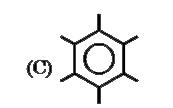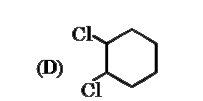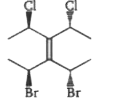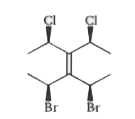Which of following is/are capable of showing geometrical isomerism:
Et−CH=N−Me



To solve the question about geometrical isomerism, we need to identify the compounds that can exhibit this type of isomerism. Geometrical isomerism occurs due to the restricted rotation around a double bond or a ring structure, leading to different spatial arrangements of groups attached to the carbon atoms.
1. Identify the Compounds: List the compounds given in the question that may show geometrical isomerism. Common examples include alkenes (due to C=C double bonds) and certain cyclic compounds.
2. Check for Double Bonds or Rings: For each compound, check if there is a carbon-carbon double bond (C=C) or a cyclic structure. These features are essential for geometrical isomerism.
3. Analyze Substituents: For compounds with double bonds, analyze the substituents attached to the carbon atoms involved in the double bond. Geometrical isomerism can occur when:
- The two carbon atoms of the double bond have different substituents.
- The substituents can be arranged in different spatial orientations (cis and trans).
4. Count the Isomers: For each compound that can show geometrical isomerism, count the number of distinct isomers (cis and trans forms).
5. Conclusion: Based on the analysis, conclude which compounds are capable of showing geometrical isomerism.
Example Application:
- Compound A: C2H4 (Ethylene) - Shows geometrical isomerism (cis and trans forms).
- Compound B: C3H6 (Propene) - Does not show geometrical isomerism as it does not have two different substituents on the double bond.
- Compound C: C4H8 (Butene) - Shows geometrical isomerism (cis and trans forms).
- Compound D: Cyclohexane - Shows geometrical isomerism due to its ring structure.
Final Answer:
Based on the analysis, the compounds that can show geometrical isomerism are those with double bonds or rings that have different substituents.
---
- The two carbon atoms of the double bond have different substituents.
- The substituents can be arranged in different spatial orientations (cis and trans).
- Compound B: C3H6 (Propene) - Does not show geometrical isomerism as it does not have two different substituents on the double bond.
- Compound C: C4H8 (Butene) - Shows geometrical isomerism (cis and trans forms).
- Compound D: Cyclohexane - Shows geometrical isomerism due to its ring structure.
Based on the analysis, the compounds that can show geometrical isomerism are those with double bonds or rings that have different substituents.
Topper's Solved these Questions
- BOOK - ALLENCHAPTER - TEST PAPERSEXERCISE - MATHEMATICS65videos
TEST PAPERS
- BOOK - ALLENCHAPTER - TEST PAPERSEXERCISE - PHYSICS4videos
TEST PAPERS
- BOOK - ALLENCHAPTER - TEST PAPERSEXERCISE - part-2 Mathematics48videos
TEST PAPERS
- BOOK - ALLENCHAPTER - TEST PAPEREXERCISE - CHEMISTRY SECTION-II3videos
TEST PAPER
Similar Questions
Knowledge Check
- Question 1 - Select One
Which of the following compound will not show geometrical isomerism across the it π-bond ?
A B
B C
C D
D
Which one of the following will be able to show geometrical isomerism if complexes are square planar? .
View SolutionWhich of the following molecules cannot show geometric isomerism ?
View SolutionWhich of the following compounds will not show geometrical isomerism?
View SolutionWhich complexes show geometrical isomerism ?
View SolutionWhich of the following compound can not show geometrical isomerism?1
View SolutionCan 2-pentene show geometrical isomerism ?
View Solution1-butene cannot show geometrical isomerism.
View Solution

